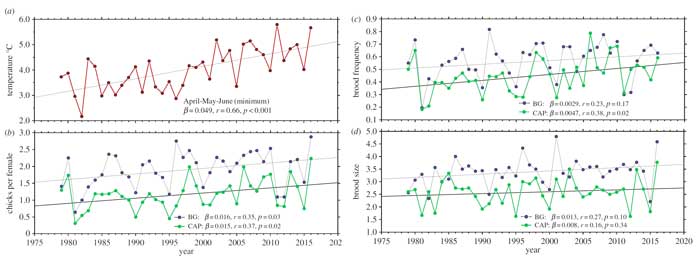| Tweet | Follow @co2science |
Paper Reviewed
Wegge, P. and Rolstad, J. 2017. Climate change and bird reproduction: warmer springs benefit breeding success in boreal forest grouse. Proceedings of the Royal Society B 284: 20171528.
Among the seemingly never-ending (though usually disproven) negative predictions associated with CO2-induced global warming, is the claim that rising temperatures will adversely impact the breeding success of birds (e.g., Virkkala et al., 2008). In short, hotter spring weather is hypothesized to cause earlier mating and a temporal mismatch with food resources during the optimum interval for egg hatching and offspring growth. However, as noted in several prior reviews we have posted on this topic (see Birds (General) and Extinction (Birds) in our Subject Index), there exists a large and growing body of scientific research that refutes this claim.
The latest scientific study to do so comes from a pair of Norwegian researchers, Wegge and Rolstad (2017), who investigated the impact of April-June weather-related variables on the breeding success of two boreal forest grouse species, black grouse (Tetrao tetrix) and sympatric capercaillie (Tetrao urogallus), over a 38-year period (1979-2016). Their study location encompassed approximately 100 square kilometers in southeast Norway, a large portion of which was located within the Varald State Forest. And what did their analysis reveal?
With respect to changes in climate, no long-term trend was detected in precipitation during the breeding season (April-June), but it was quite a different story for temperature. Average April-June minimum temperatures rose approximately 2°C over the four decades (see Figure 1a), which rise correlated best with breeding success in both bird species. With respect to changes in breeding success, Wegge and Rolstad report that this parameter "increased markedly" during the 38-year period. Indeed, as measured by the number of chicks per female, Figure 1b illustrates the 38 and 62 percent increase in breeding success for black grouse and capercaillie, respectively, over the past four decades, which success exhibited a positive, statistically significant relationship with minimum temperatures during the breeding season. Additionally, as shown in Figure 1c and 1d, brood frequency and brood size also increased during the study period.
The combination of findings reported above led Wegge and Rolstad to state the obvious, that "contrary to the prediction that global warming will adversely affect reproduction in boreal forest grouse, our study shows that breeding success was enhanced in warmer springs," adding that their work "does not lend evidence to the general notion that warmer climate will adversely affect the reproduction of birds and animals in northern latitudes," but that "warmer springs may even enhance the breeding performance of boreal forest grouse" in the future (emphasis added).

Figure 1. (Panel a) April-June averages of minimum daily temperatures, (Panel b) breeding success (chicks per female), (Panel c) brood frequency (females with broods), and (Panel d ) brood size in capercaillie (CAP) and black grouse (BG) during 1979-2016. Source: Wegge and Rolstad (2017).
Reference
Virkkala, R., Heikkinen, R.K., Leikola, N. and Luoto, M. 2008. Projected large-scale range reductions in northern-boreal land bird species due to climate change. Biological Conservation 141: 1343-1353.




